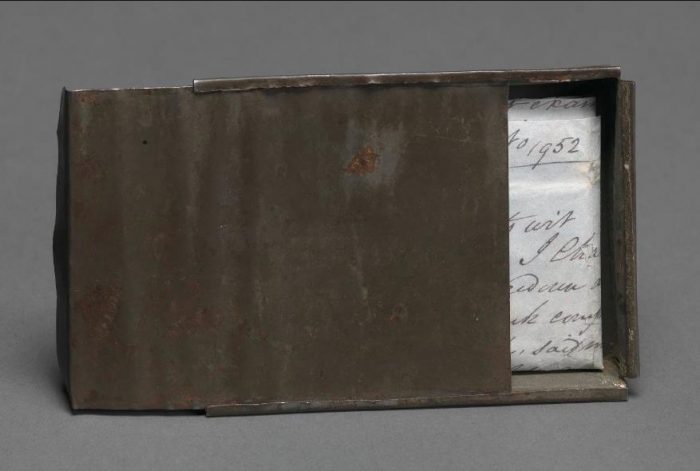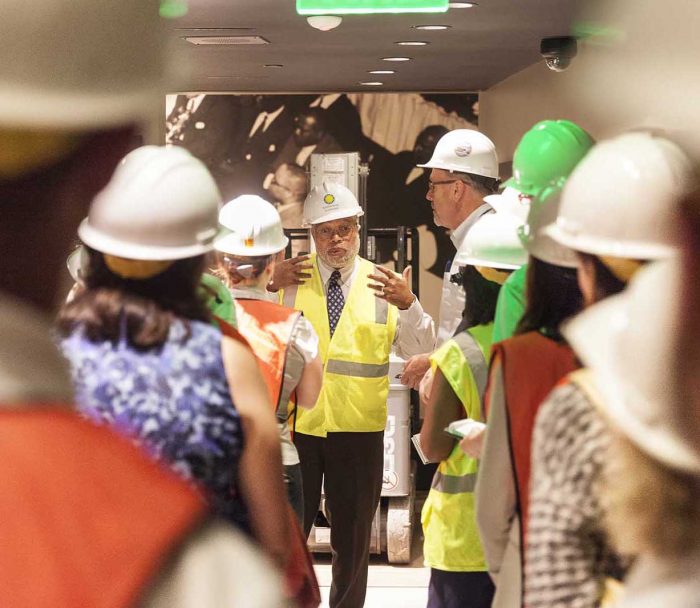Our History, Our Culture
With the opening of the National Museum of African American History and Culture this month, the Smithsonian gains a valuable and vital asset, essential to discovering, understanding and sharing the past, present, and future of America. Creating the museum was a huge undertaking, and no one knows this better than Lonnie Bunch, noted scholar and founding director. I spoke with Lonnie to learn about the achievements and ambitions of the newest member of our museum family.

Lonnie Bunch, director of the Smithsonian’s National Museum of African American History and Culture, speaks at the museum’s groundbreaking ceremony on the National Mall in Washington, D.C. on Feb. 22, 2012, flanked by Smithsonian Secretary G. Wayne Clough, First Lady Michelle Obama and President Barack Obama. (Photo by John Gibbons)
David Skorton: After being named director in 2005, you moved full-steam forward to develop the collection, construct the building, create exhibits and programs, and raise the money. You’ve set a very high bar for multi-tasking: what is the secret of your success?
Lonnie Bunch: I think it’s about being smart enough to surround yourself with gifted people and being dumb enough to not know what you can’t do. To succeed took stamina, but I had a chance to honor the Smithsonian and the African American community, so I thought it was crucial to do the best we could.
You have crisscrossed the country and beyond, building the collection, meeting people, and promoting the museum. Is there one experience that was especially surprising or moving?
What I have been touched by is that people seem to have been waiting for this moment, to share things with us. They are trusting us with their treasures. It is that sense of trust that moves me so much. Every week someone comes up to me and thanks me for what we’re doing, and they often add that they are praying for us. It’s very touching. Never turn down a prayer.
Do you have a favorite artifact, one that means a lot to you personally?
It’s hard to identify a favorite, but one object that means a lot to me is Joseph Trammell’s wallet. Mr. Trammell was a slave in Loudoun County who gained his freedom in the 1850s. He kept the piece of paper certifying he was free in a handmade tin wallet. Every day he would fold up the paper, put it in the wallet, and keep it with him. The wallet protected the paper that guaranteed his freedom. In the evening, he would take the certificate out of the wallet, to show his family. The fact that his family kept it, and that his descendants gave it to us, was very humbling for me.

Joseph Trammell (1831 – 1859) made this tin box in 1852 to hold the papers giving him his freedom. Collection of the Smithsonian National Museum of African American History and Culture, Gift of Elaine E. Thompson, in memory of Joseph Trammell, on behalf of his direct descendants.

The Certificate of Freedom issued to Joseph Trammell by the Loudon County Court on May 10, 1852. Collection of the Smithsonian National Museum of African American History and Culture, Gift of Elaine E. Thompson, in memory of Joseph Trammell, on behalf of his direct descendants
We know that learning about artifacts in museum settings can create positive, lifelong memories in children. How has that fact influenced your approach to exhibits and activities for kids?
Some of my earliest memories as a teen involve visiting the Smithsonian, and seeing objects like the trains and the Hope Diamond. At one point, we discussed the possibility of a totally interactive installation, without artifacts. But my memories reminded me of the power of the authentic—seeing people cry when they saw the Star-Spangled Banner, and being moved by the Greensboro lunch counter. It was this power that inspired our decision. Objects help people remember, move them, and instill a sense of purpose.
With all you have accomplished, is there any challenge that stands out, something you would have done differently?
Fundraising was the most challenging responsibility, but building the collection was the most overwhelming. The greatest obstacle was convincing people that the museum would actually happen. After all, the idea for this museum was first suggested 100 years ago, and there were so many stops and starts long the way.

Lonnie Bunch leads staff on a hardhat tour of the museum before its Sept. 24 opening to the public. (Photo by Eric Long)
Many people will hear about the museum and wonder whether they should travel to Washington to experience it for themselves. What would you say to convince them?
I think that this is a museum worthy of the Smithsonian, so that alone should persuade them. The objects on display, many of which have never been seen by the public, have such meaning. The stories they evoke will help people think about their history in new ways. The museum is more than a people’s journey – it’s a nation’s story. People of different ages and backgrounds will experience the museum in different ways. The richness and fullness of our approach will serve all visitors, whether they lived through the Civil Rights era or grew up in the Age of Obama.
Once the opening is behind us and the museum is operating smoothly, what’s next on the agenda for NMAAHC?
Besides sleeping, we will be working to make the museum a space for expressing and sharing views. You can’t explore the African-American experience historically without discussing difficult issues such as racial inequality, sexual aggression, and violence. To provide a place for people to safely debate these issues, and help make America better, is one of our goals.
What are you going to do to celebrate?
I plan to go to a beach and lock the cell phone away for as long as humanly possible.
My family and I are really looking forward to the opening. My Mom will be there, too. The thought of having her with us is what has kept me going.

The Smithsonian’s National Museum of African American History and Culture, April 13, 2016. (Photo by Alan Karchmer)
Posted: 31 August 2016




I`m looking forward to being there on sept 24 being part of this history making event.